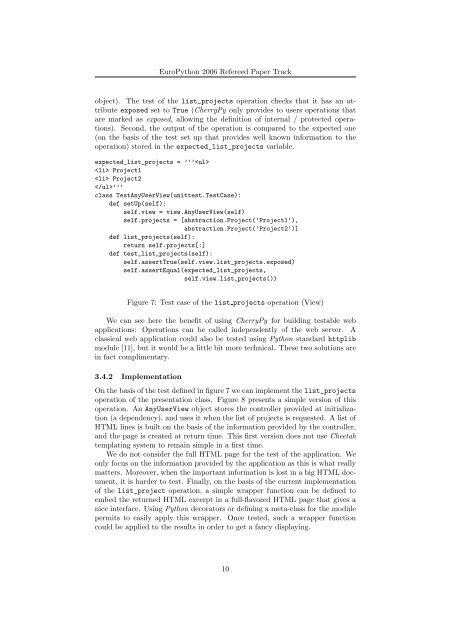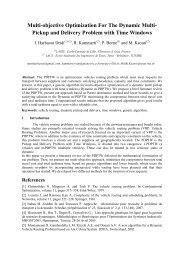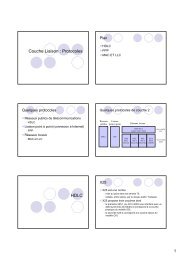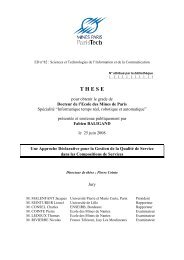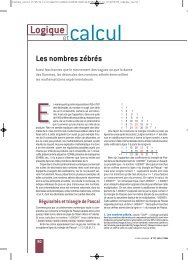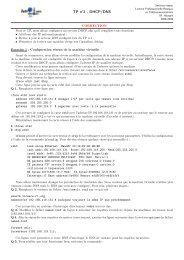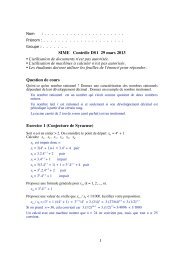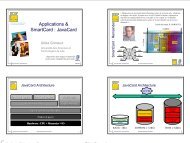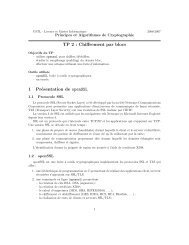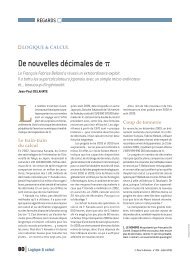An Introduction to Test-Driven Code Generation - LIFL
An Introduction to Test-Driven Code Generation - LIFL
An Introduction to Test-Driven Code Generation - LIFL
Create successful ePaper yourself
Turn your PDF publications into a flip-book with our unique Google optimized e-Paper software.
EuroPython 2006 Refereed Paper Track<br />
object). The test of the list_projects operation checks that it has an attribute<br />
exposed set <strong>to</strong> True (CherryPy only provides <strong>to</strong> users operations that<br />
are marked as exposed, allowing the definition of internal / protected operations).<br />
Second, the output of the operation is compared <strong>to</strong> the expected one<br />
(on the basis of the test set up that provides well known information <strong>to</strong> the<br />
operation) s<strong>to</strong>red in the expected_list_projects variable.<br />
expected_list_projects = ’’’<br />
Project1<br />
Project2<br />
’’’<br />
class <strong>Test</strong><strong>An</strong>yUserView(unittest.<strong>Test</strong>Case):<br />
def setUp(self):<br />
self.view = view.<strong>An</strong>yUserView(self)<br />
self.projects = [abstraction.Project(’Project1’),<br />
abstraction.Project(’Project2’)]<br />
def list_projects(self):<br />
return self.projects[:]<br />
def test_list_projects(self):<br />
self.assertTrue(self.view.list_projects.exposed)<br />
self.assertEqual(expected_list_projects,<br />
self.view.list_projects())<br />
Figure 7: <strong>Test</strong> case of the list projects operation (View)<br />
We can see here the benefit of using CherryPy for building testable web<br />
applications: Operations can be called independently of the web server. A<br />
classical web application could also be tested using Python standard httplib<br />
module [11], but it would be a little bit more technical. These two solutions are<br />
in fact complimentary.<br />
3.4.2 Implementation<br />
On the basis of the test defined in figure 7 we can implement the list_projects<br />
operation of the presentation class. Figure 8 presents a simple version of this<br />
operation. <strong>An</strong> <strong>An</strong>yUserView object s<strong>to</strong>res the controller provided at initialization<br />
(a dependency), and uses it when the list of projects is requested. A list of<br />
HTML lines is built on the basis of the information provided by the controller,<br />
and the page is created at return time. This first version does not use Cheetah<br />
templating system <strong>to</strong> remain simple in a first time.<br />
We do not consider the full HTML page for the test of the application. We<br />
only focus on the information provided by the application as this is what really<br />
matters. Moreover, when the important information is lost in a big HTML document,<br />
it is harder <strong>to</strong> test. Finally, on the basis of the current implementation<br />
of the list_project operation, a simple wrapper function can be defined <strong>to</strong><br />
embed the returned HTML excerpt in a full-flavored HTML page that gives a<br />
nice interface. Using Python decora<strong>to</strong>rs or defining a meta-class for the module<br />
permits <strong>to</strong> easily apply this wrapper. Once tested, such a wrapper function<br />
could be applied <strong>to</strong> the results in order <strong>to</strong> get a fancy displaying.<br />
10


